
At first glance, it doesn’t look like much is going on…
The garden looked hunkered down and frozen the other day, and well it should, since 10 degrees was a mite chilly for Birmingham, Alabama.
While gardeners in northern climes take the winter off, perusing catalogues and dreaming of a new garden season still months away, usually we in the south, like it or not, don’t have any real down time. I seem to spend much of mine walking through the garden and simply observing and thinking about what needs doing, and, when the temperatures drop down below freezing, I’m more than happy to stay inside.
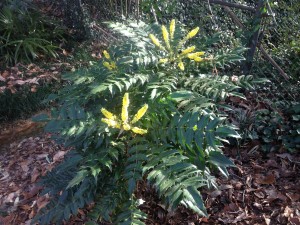
Mahonia ‘Charity’, adding it’s winter color…
For example, I’ve been thinking on and off for over a year now about moving one of the shrub roses from the front bed to the side of the driveway but haven’t quite gotten past the thinking stage yet. I’ve become much more relaxed about things; everything will get done in its own time. Don’t sweat the small stuff, right?
Here’s a bit from a post written last winter with some additional notes about what differences a year can make.

The mahonia, a year later, January, 2015
I see the Mahonia x media ‘Charity’ shrub that’s planted in a very shady spot is blooming. The birds love the blue/purple berries that follow the bright yellow flowers, and we don’t see the pretty fruit for long. I cut it back quite hard last spring because it was getting leggy. It’s fuller as a result this year, and next year will have even more blooms. (A note: This year, 2015, there are more blooms, and they’re bigger too!)

Chamaecyparis obtusa selections are wonderful for the south…

Groundcovers… Veronica ‘Georgia Blue’ and a dianthus…

Candytuft, catmint, poppies…
Chamaecyparis obtusa ‘Golden Mop’ calls attention to itself out front with some yellow brightness of its own, anchoring the end of the front bed. It has loved this hot, sunny spot, and I appreciate being able to clip it for my holiday decorations. What a beautiful workhorse in the garden! I purchased it (and most of my shrubs and trees) in small pots and have let them grow into their spaces.
More subtle things are happening out front too. The early blooming evergreen groundcover Iberis, or candytuft, is showing its buds, and some are even opening. They evidently don’t look at a calendar or gardening book to tell them when they’re supposed to be blooming! (Update for 2015: definitely not as pretty as last year, but there’s still a smattering of bloom here and there.)
The veronica ‘Georgia Blue’, a white pass-along dianthus, and poppies seem happy, as does the catmint, ‘Walker’s Low’. The beautiful veronica will be covered with tiny blue flowers in late January into February, just as the poppies begin to fatten up and the violas begin to show more color. If you haven’t planted poppies, pansies, violas, the ‘Georgia Blue’ veronica or candytuft yet, it’s not too late to find a few spots for some. They’ll add some extra and welcome color in your yard this spring.
This bed will look much different in future weeks and months, but now, in the midst of winter, things are quiet…I must remember this is the season for patience.

daylily foliage…
Some daylilys, though, are pushing out new green growth in this warm south facing bed; winter barely keeps them down. A large prostrate rosemary, another that loves this hot spot, is blooming pretty purply blue flowers that the bees adore. (This Rosemary really took a hit during the second snow event of 2014 – I ended up pulling it out early in the summer since it looked absolutely awful.)

Spiraea ‘Ogon’
My route has taken me again to the back, where the Spiraea ‘Ogon’ is holding on to its few remaining willowy leaves, and, looking closely, I can see all the little buds along the stem. These will result in pretty white blooms in beautiful contrast with chartreuse new growth this spring. (this year – no leaves, hoping it blooms as well as last year.)
I walk down another level and there’s one of many small Alabama crotons, looking a bit bedraggled, still with a few silver backed orange leaves. The crotons love this part of my garden – thankfully, since it’s on a rocky slope with great drainage that they prefer.
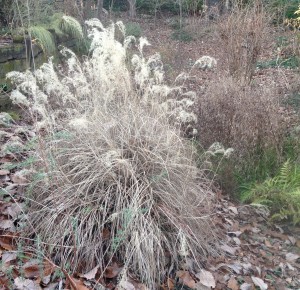
sun shining through a miscanthus…
Farther on, the plumes of a miscanthus show off in the afternoon light. This year, 2015, it looks so sad I won’t hesitate cutting it back next month. This will also keep all those seeds from wanting to sprout here and there. My Midwestern soul loves grasses… but not everywhere!
I notice this year that the pieris is fat and full of buds – the cold doesn’t seem to have affected it at all, at least I hope it hasn’t. It may be in a favorable microclimate – warmed by the rock outcrop just behind it, and the water below.

The Japanese pieris is full of buds…

epimedium spreads slowly…
I make my way across the water and toward the rocks where an epimedium resides in the shelter and shade of a large elm.
I’ll be trimming it’s tattered winter foliage soon in anticipation of the dainty orange flowers that will appear early spring. There is no procrastinating with epimedium; if I wait too long to clean up those tattered leaves, I risk cutting the delicate stems the flowers arise on. These small lessons are often learned by doing the wrong thing at least once. I love all the different epimediums I’ve amassed over the years. They are slow growing, tough shade groundcovers – some evergreen, some not, and all very beautiful, even without flowers!
(Unfortunately the summer of 2014 a woodchuck created some serious mayhem in the garden, eating all the buds of the epimedium and the blue woodland phlox as well. It was so disappointing! I’m hoping this spring is better.)
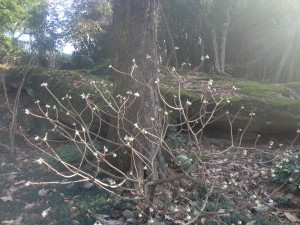
Edgeworthia chrysantha…
One shrub I never prune but let have it’s way, and that always blooms in the winter is the Edgeworthia chrysantha, or paper bush. I see the beautiful buds that have been getting larger all fall; soon they’ll begin to open and their incredible scent will fill the garden. It’s a true gem, holding interest in all the seasons, from it’s long lasting pretty buds to fragrant blooms, interesting bark, and big, bold leaves.

January, 2015

Native cardamine…
I need to end this post soon…Oh, but here, coming up through fallen leaves, is the Cardamine diphylla. I have this native in many spots under the shade of large trees. It will sport pretty white blooms on tall stems in late spring, but it’s the winter when the foliage is at it’s prettiest. By summer it will have retreated below ground once again. This winter it’s spread even more, and the pretty green foliage really stands out against the brown leaves beneath it.

Carex ‘Evergold’

Parney’s clusterberry cotoneaster…the cedar wax wings will devour these berries in another few weeks!
Carex is another favorite, and here is Carex ‘Evergold’, spilling from a planter. Look how bright is is in the shade of a Cotoneaster lacteus – ‘Parney’s Clusterberry.

Oh so fragrant…daphne odora
Finally, the daphne odora’s pink buds are getting larger, and soon they’ll open, adding their incredible scent to the whole back garden. This is one that I leave well alone – it needs perfect drainage, and on this slope it seems to be happy. Too much coddling and they are prone to up and dying. So far I’ve been lucky with this one.
The light is beginning to fade and there’s a definite chill in the air; it’s time to go in. There will certainly be more ups and downs with our weather this winter – that’s a given. Finally, though, temperatures will gradually begin to rise as we make our way toward spring, and each day there will be more to see. I’m ready.
 I have a tiny oak tree out back that used to be on its way to attaining an impressive size – until Hurricane Ivan hit and toppled a huge hickory tree onto it, effectively topping it.
I have a tiny oak tree out back that used to be on its way to attaining an impressive size – until Hurricane Ivan hit and toppled a huge hickory tree onto it, effectively topping it.
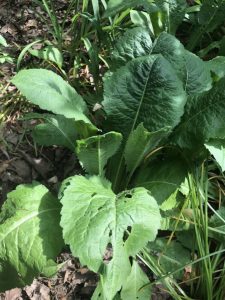 “Plants are living things like humans. They need water and sun and some need food and each grow in different ways. That yellow leaf at the bottom of the dracaena doesn’t mean that there is something wrong or that the plant is dying – it’s just a natural part of the life cycle. People need to understand that imperfect is beautiful.”
“Plants are living things like humans. They need water and sun and some need food and each grow in different ways. That yellow leaf at the bottom of the dracaena doesn’t mean that there is something wrong or that the plant is dying – it’s just a natural part of the life cycle. People need to understand that imperfect is beautiful.”



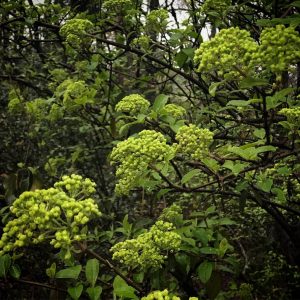








































 Here also are pictures of a couple of groupings I pulled together to give you an idea of what is available as of October, 2014. In the first picture, left-right and front-back, they’re as follows:
Here also are pictures of a couple of groupings I pulled together to give you an idea of what is available as of October, 2014. In the first picture, left-right and front-back, they’re as follows: Interesting choices, right? Here’s another grouping, again L-R and front-back:
Interesting choices, right? Here’s another grouping, again L-R and front-back:

 The temperatures are hopefully trending downward, and you’re thinking about redoing your summer plantings. There seem to be so many choices; it’s normal to feel overwhelmed at the garden shop, even though you probably thought you had it all figured out before you left home!
The temperatures are hopefully trending downward, and you’re thinking about redoing your summer plantings. There seem to be so many choices; it’s normal to feel overwhelmed at the garden shop, even though you probably thought you had it all figured out before you left home! The large planter here is one of a pair, used at the top of stairs leading onto a wide open porch. I took my color cues from the red brick and cream color of the house in choosing my plants, using predominantly yellow with the evergreen Chamaecyparis ‘Crippsii’, yellow variegated Acorus ‘Ogon’, golden creeping Jenny to trail, and Matrix ‘Lemon’ pansies. To this I added ornamental red mustard, and a chard with red stems called ‘Charlotte’. These will add big, bold leaves, beautiful foliage color, and added height.
The large planter here is one of a pair, used at the top of stairs leading onto a wide open porch. I took my color cues from the red brick and cream color of the house in choosing my plants, using predominantly yellow with the evergreen Chamaecyparis ‘Crippsii’, yellow variegated Acorus ‘Ogon’, golden creeping Jenny to trail, and Matrix ‘Lemon’ pansies. To this I added ornamental red mustard, and a chard with red stems called ‘Charlotte’. These will add big, bold leaves, beautiful foliage color, and added height. These planters are quite large and can support this variety of plants. In smaller planters, a smaller shrub, some curly parsley, pansies and a trailing plant might be sufficient. Remember, more is always better in planters and windowboxes to give them a lush overflowing feel.These planters will make a definite statement as they grow out.
These planters are quite large and can support this variety of plants. In smaller planters, a smaller shrub, some curly parsley, pansies and a trailing plant might be sufficient. Remember, more is always better in planters and windowboxes to give them a lush overflowing feel.These planters will make a definite statement as they grow out.
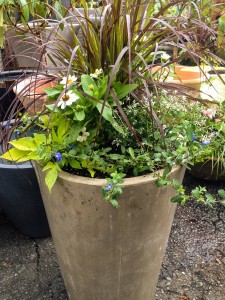 The next uses a red fountain grass for height in a tall planter with the addition of white Profusion zinnias and white euphorbia as fillers. Spilling out are blue daze and potato vine. This planting will bloom continuously with regular water and periodic deadheading or clipping back of the zinnias. Late in the summer the grass will begin to bloom for an end of the season finale.
The next uses a red fountain grass for height in a tall planter with the addition of white Profusion zinnias and white euphorbia as fillers. Spilling out are blue daze and potato vine. This planting will bloom continuously with regular water and periodic deadheading or clipping back of the zinnias. Late in the summer the grass will begin to bloom for an end of the season finale.
 Many of you have pots that have shrubs in them that live year round, and just need some color added each season. In this example, the Chamaecyparis adds yellow foliage and is complimented through the summer with yellow million bells, white narrow leaf zinnias, silver dichondra and some euphorbia. The million bells and zinnias will be cut back when they get too leggy (There’s no need to deadhead each individual bloom on these.) and it will be watered daily, since the Chamaecyparis has been in this planter for a few years and it’s roots are filling the planter quite extensively.
Many of you have pots that have shrubs in them that live year round, and just need some color added each season. In this example, the Chamaecyparis adds yellow foliage and is complimented through the summer with yellow million bells, white narrow leaf zinnias, silver dichondra and some euphorbia. The million bells and zinnias will be cut back when they get too leggy (There’s no need to deadhead each individual bloom on these.) and it will be watered daily, since the Chamaecyparis has been in this planter for a few years and it’s roots are filling the planter quite extensively. The final planting uses a dramatic, and very large Alocasia – this speaks for itself, though it has supporting players as well, including dracaena, epescia, nepenthes, and alternanthera. It’s quite a combo.
The final planting uses a dramatic, and very large Alocasia – this speaks for itself, though it has supporting players as well, including dracaena, epescia, nepenthes, and alternanthera. It’s quite a combo.
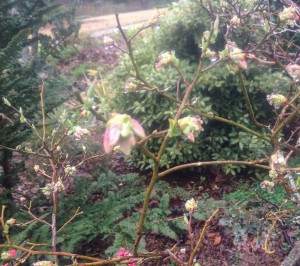
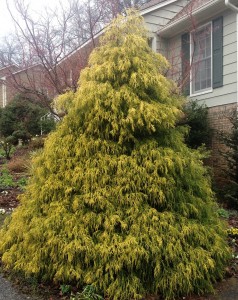
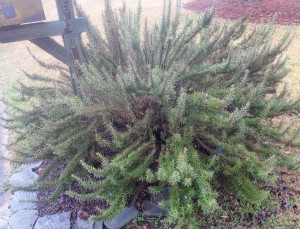

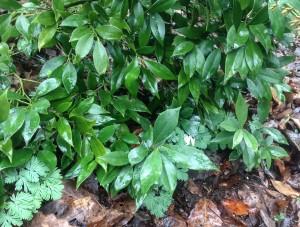





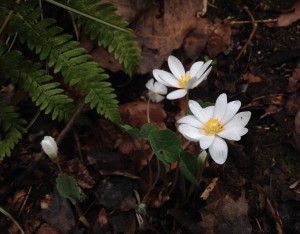







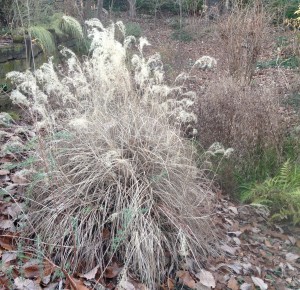

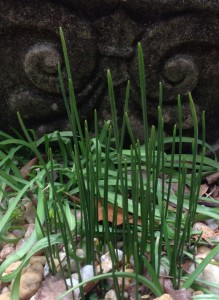








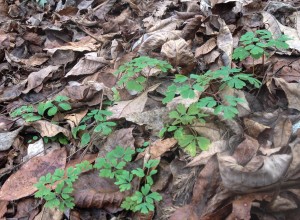










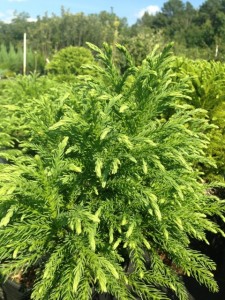

 With 2013 beginning with a wet, cool spring and the rain continuing into early summer, it seemed like we’d been transported into a different universe than Alabama, didn’t it? All the rain may have caused some complacency – everything seems so much lusher than it usually is this time of year…now the heat is here, though, and it seems certain we’ll be entering our usual summer pattern of hit and miss rain showers with lots of warmth and humidity…
With 2013 beginning with a wet, cool spring and the rain continuing into early summer, it seemed like we’d been transported into a different universe than Alabama, didn’t it? All the rain may have caused some complacency – everything seems so much lusher than it usually is this time of year…now the heat is here, though, and it seems certain we’ll be entering our usual summer pattern of hit and miss rain showers with lots of warmth and humidity…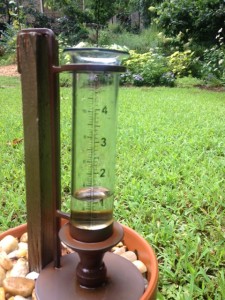 Established plantings in your landscape should be doing well, but be aware that new plantings of shrubs, trees and perennials will need supplemental watering this first summer – pay attention to them. The requirement for new plantings is an inch of water each week.
Established plantings in your landscape should be doing well, but be aware that new plantings of shrubs, trees and perennials will need supplemental watering this first summer – pay attention to them. The requirement for new plantings is an inch of water each week.